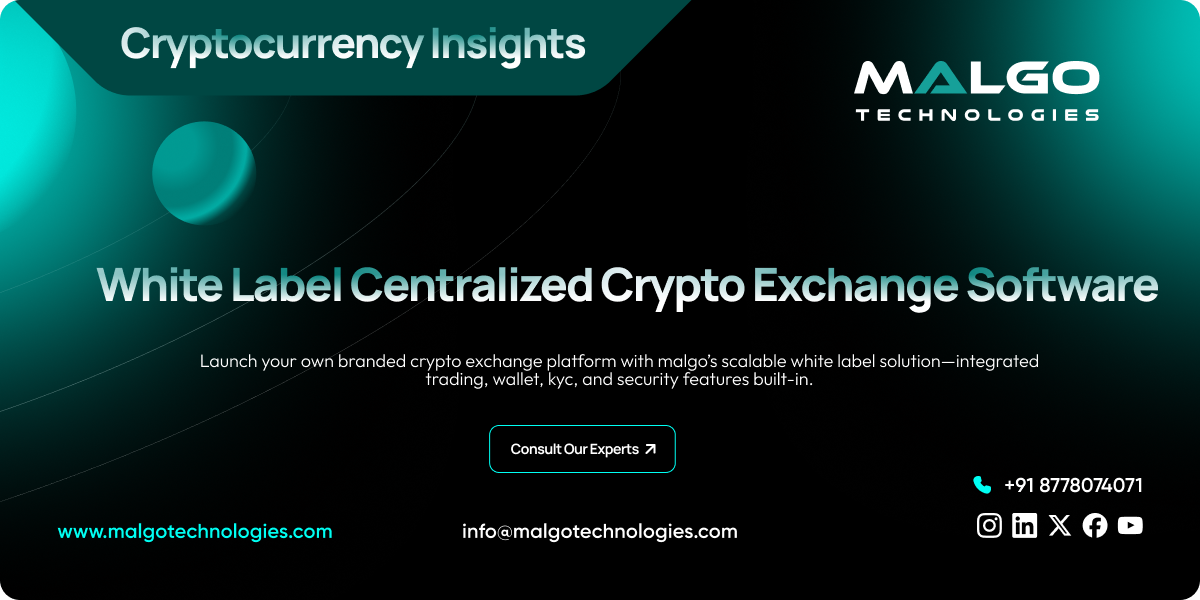Introduction
The cryptocurrency market continues to influence digital finance, with centralized crypto exchanges acting as the primary hub for trading activity. Launching such an exchange from scratch involves intricate development timelines and intensive technical resources. This is where White Label Centralized Crypto Exchange Software steps in as a practical alternative.
What is White Label Centralized Crypto Exchange Software?
White label centralized exchange software is a pre-built, fully functional solution that allows companies to deploy a branded crypto trading platform with minimal development effort. It includes essential trading features, admin modules, and user-side components, making it a convenient starting point for businesses looking to enter the exchange space without building everything from zero.
Why Businesses Option for White Label Solutions
The primary draw is speed. White label solutions provide a quick way to enter the crypto trading market without handling the core infrastructure. These platforms come tested, stable, and flexible enough for branding, feature customization, and scaling as user demands grow.
How Centralized Crypto Exchanges Work
Understanding the structure behind centralized exchanges helps clarify what a white label platform offers.
Basic Architecture of Centralized Exchanges
At their core, centralized exchanges rely on a server-client architecture. Orders are stored and matched on centralized servers. Backend modules handle order books, wallets, trading engines, and admin controls. The front end delivers an interface for users and administrators.
User Flow: Registration to Trade Execution
Users begin by creating accounts, completing KYC, and depositing funds. Once verified, they can place orders, which the platform matches using its trading engine. Trades execute in real-time, and balances update accordingly. Withdrawals follow security checks before approval.
Admin Functions and Controls
Admins can monitor user activity, manage listed tokens, adjust trading pairs, view reports, configure commissions, and handle disputes. The admin panel also includes modules for KYC/AML verification, compliance, liquidity management, and platform-wide configurations.
Key Features of White Label Centralized Exchange Software
Malgo’s white label centralized crypto exchange development focuses on delivering complete feature parity with top-tier exchanges. Here are the standard components included:
Multi-Currency Wallet Integration
Support for multiple crypto wallets with hot and cold wallet segregation to manage user funds securely.
KYC/AML Verification System
Automated and manual tools to handle user identity verification and comply with anti-money laundering regulations.
Order Matching Engine
A high-performance matching engine capable of handling thousands of transactions per second with low latency.
Admin Dashboard and User Management
Comprehensive controls for managing users, setting trading fees, configuring roles, and moderating transactions.
Liquidity Management
Built-in APIs and market-making tools to connect with liquidity providers and maintain healthy order books.
Trade History and Reporting Tools
Access to transaction logs, user trade history, and financial reports for compliance and operational oversight.
Security Protocols
Includes two-factor authentication (2FA), end-to-end encryption, DDoS protection, and anti-bot firewalls.
Benefits of Using White Label Exchange Software
Choosing a white label route for centralized crypto exchange development brings several operational benefits:
Faster Deployment
Since the base platform is already built, projects can move from idea to launch in a significantly shorter time.
Reduced Development Costs
Avoids the overhead of building every component from scratch, saving on both backend and frontend development.
Pre-Tested Infrastructure
The platform comes pre-audited and field-tested, reducing the risks associated with system bugs or vulnerabilities.
Easy Customization and Branding
Logos, color schemes, trading pairs, and features can be modified based on project goals and target markets.
Scalability Options
The architecture supports performance upgrades as user volume and trading activity grow.
Customization Options Available in White Label Exchange Software
While the software provides a ready-made core, it allows a high degree of flexibility to align with project requirements.
UI/UX Personalization
Adjust themes, layouts, and user experience flow to reflect brand identity and regional audience behavior.
Token Listing and Trading Pair Configuration
Add or remove tokens and define trading pairs with base and quote currencies based on market strategy.
Language and Regional Support
Integrate multi-language options and geo-compliant modules to meet jurisdiction-specific standards.
Commission and Fee Structure Settings
Define maker/taker fees, withdrawal charges, and referral bonuses from the admin panel.
Tech Stack Behind a Centralized Exchange
Malgo’s centralized crypto exchange development process leverages stable, scalable technologies:
Backend: Node.js, Go, Python
Frontend: React, Angular, Vue.js
Database/Cache: PostgreSQL, Redis
Blockchain Integration: Full-node APIs and third-party blockchain services
Infrastructure: Docker, Kubernetes, AWS, GCP, or on-premise hosting setups
Security Considerations in White Label Exchange Software
Security is non-negotiable in exchange platforms. Malgo integrates multiple layers of protection.
Wallet Security
Hot wallets are monitored, and cold wallets are used for bulk storage with restricted access.
Secure APIs
All APIs are encrypted, and rate-limited to reduce the attack surface.
Anti-Fraud Systems
Automated alerts, user behavior tracking, and AI-powered monitoring for suspicious activities.
Compliance Management
Adheres to global compliance frameworks like GDPR, FATF, and supports country-specific regulations.
Who Should Consider a White Label Crypto Exchange?
White label solutions fit a wide range of stakeholders:
Entrepreneurs and Startups: Quick market entry without managing full-stack development.
Traditional Financial Institutions: Expand digital asset offerings securely.
Crypto Brokerage Firms: Add new services with branded platforms.
NFT and Token Projects: Build a custom exchange for project-native token utility.
Cost to Launch a White Label Centralized Crypto Exchange
Launching a centralized exchange involves planning for licensing, development, integrations, and long-term maintenance. Malgo works with clients to identify needs and deliver solutions that match technical and business requirements.
Why Choose Malgo for White Label Crypto Exchange Software Development?
Malgo brings deep technical experience and proven infrastructure in centralized crypto exchange development.
Our Development Process
From discovery to deployment, each phase is structured to balance performance, compliance, and future readiness.
Feature-Rich, Scalable Architecture
The platform supports growing user bases, international transactions, and increasing trade volumes without reworking the core.
Post-Launch Support and Maintenance
Malgo continues support with security patches, performance updates, technical documentation, and platform upgrades.
Final Thoughts
Centralized crypto exchanges remain a dominant force in the digital asset space. For businesses looking to build a presence quickly, a white label approach provides a practical entry point. With the right partner, reliability, compliance, and scalability become deliverables—not challenges.
Frequently Asked Questions
Yes. The platform allows token listings and custom trading pair configurations.
Yes, fiat gateways can be integrated based on supported regions and compliance.
Yes, APIs can be used to connect external liquidity sources or set up internal market-making tools.
The UI is fully customizable based on branding, theme, and layout preferences.
Ethereum, BNB Chain, Polygon, Solana, and other EVM-compatible networks are supported. Additional chains can be integrated on request.


